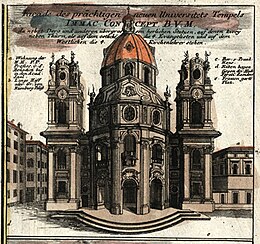The Missa brevis in D minor, K. 65/61a, is a mass composed by Wolfgang Amadeus Mozart (12 years old at the time) and completed on 14 January 1769.[1] It is scored for SATB soloists and choir, violin I and II, 3 trombones colla parte, and basso continuo.
| Missa brevis in D minor | |
|---|---|
| Mass by W. A. Mozart | |
 Kollegienkirche, the University Church of Salzburg, c. 1712 | |
| Key | D minor |
| Catalogue | K. 65/61a |
| Occasion | Forty-hour vigil held at the Kollegienkirche |
| Composed | 1769: Salzburg |
| Movements | 6 |
| Vocal | SATB choir and soloists |
| Instrumental |
|
It is thought that this mass was performed in the University of Salzburg's Kollegienkirche to open a forty-hour vigil.[2][3] As a Lenten mass, it is likely that the Gloria could not have been performed on this occasion, and would have been composed for subsequent use.[4] This is Mozart's shortest setting of the Order of Mass, and his only missa brevis set in a minor key.[3]
The mass is divided into six movements.
- Kyrie Adagio, D minor, common time
- "Kyrie eleison" – Allegro, D minor, 3/4
- Gloria Allegro moderato, D minor, common time
- Credo Allegro moderato, D minor, 3/4
- "Et incarnatus est" Adagio, D minor, cut common time
- "Et resurrexit" Allegro moderato, D minor, 3/4
- "Et vitam venturi saeculi" Più mosso, D minor, cut common time
- Sanctus Adagio, D minor, cut common time
- "Pleni sunt coeli et terra" Allegro, D minor, common time
- "Hosanna in excelsis" Allegro, D minor, 3/4
- Benedictus Andante, G minor, common time; soprano/alto duet
- "Hosanna in excelsis" Allegro, D minor, 3/4
- Agnus Dei Andante, D minor, common time
- "Dona nobis pacem" Vivace, D minor, 3/8
References
External links
Wikiwand in your browser!
Seamless Wikipedia browsing. On steroids.
Every time you click a link to Wikipedia, Wiktionary or Wikiquote in your browser's search results, it will show the modern Wikiwand interface.
Wikiwand extension is a five stars, simple, with minimum permission required to keep your browsing private, safe and transparent.
